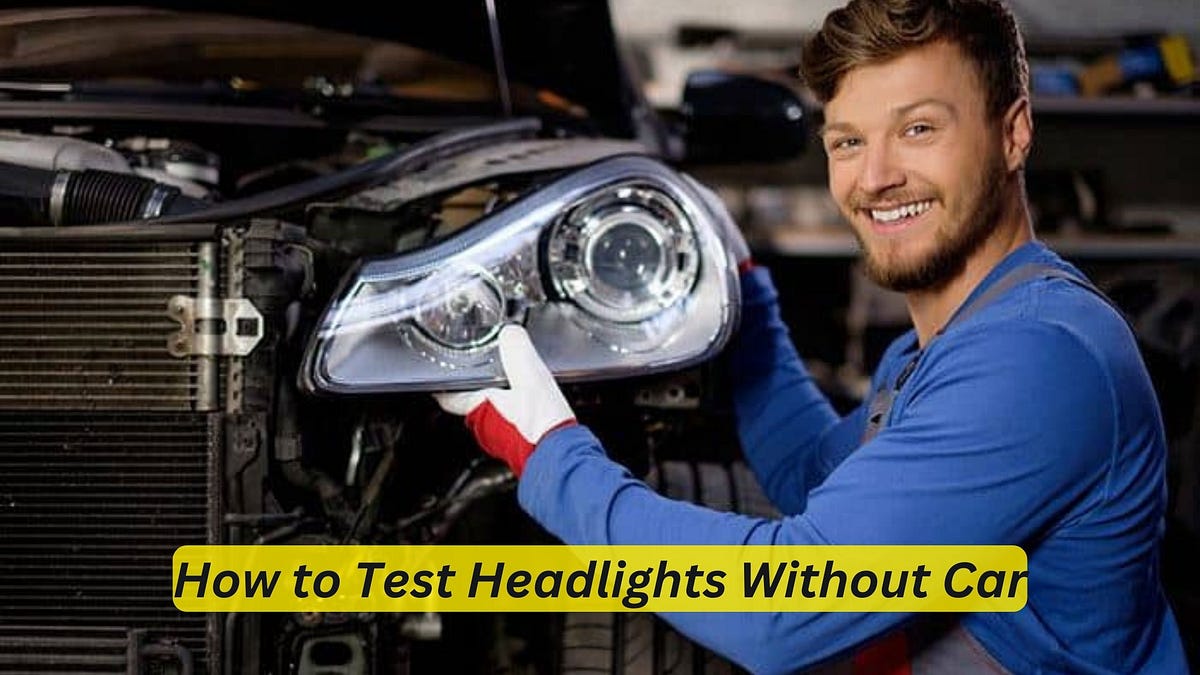How to Test Headlights Without Car
To test headlights without a car, you can connect the headlight directly to a 12V battery using jumper wires and observe if it turns on. Testing your car’s headlights is crucial for ensuring road safety.
However, if you don’t have access to a car, there are alternative methods to verify the functionality of your headlights. By connecting the headlight to a 12V battery using jumper wires, you can determine if it turns on and confirm its working condition.
This simple technique allows you to assess your headlights without the need for a vehicle. Regularly checking your headlights is vital to maintain proper visibility on the road and ensure the safety of yourself and other drivers.

Credit: medium.com
Testing Headlights
Checking Headlight Switch
Verify the headlight switch functionality by turning it on and off. A faulty switch can cause headlight issues.
Inspecting Bulbs And Wiring
Examine the bulbs for any signs of damage or burnt-out filaments. Also, check the wiring for any loose connections or frayed wires.
Using A Battery Or Power Source
Connect a battery or power source directly to the headlights to see if they illuminate. This helps determine if the bulbs are functioning.

Credit: m.youtube.com
Emergency Solutions
When it comes to testing your car’s headlights, you may find yourself in a situation where you don’t have access to a vehicle. This can be frustrating, especially in emergency situations where you need to ensure your headlights are working properly. However, there are a few temporary fixes you can try and professional help you can seek in order to test your headlights without a car.
Temporary Fixes
If you find yourself in a pinch and need to test your headlights without a car, here are a few temporary fixes you can try:
- Use a Battery: Connect the headlight directly to a battery using jumper cables to see if it lights up. Make sure you connect the positive (+) terminal of the battery to the positive (+) terminal of the headlight.
- Use a Power Supply: If you have a power supply or benchtop power source, you can connect the headlight to it and test it that way. Adjust the power supply to match the voltage requirements of your headlight.
- Inspect the Bulbs: If you can’t test the headlight directly, visually inspect the bulbs to see if they are burnt out or damaged. If you notice any issues, it’s a good indicator that you need to replace the bulbs.
Seeking Professional Help
If you’ve tried the temporary fixes and are still unsure about the condition of your headlights, it’s best to seek professional help. A qualified mechanic or auto electrician will have the necessary tools and expertise to test your headlights accurately.
They can use specialized equipment like a headlight tester to check the brightness, alignment, and overall functionality of your headlights. Additionally, they can inspect the wiring and connections to ensure everything is in proper working order.
Remember, it’s important to have functional headlights for your safety on the road. Regular testing and maintenance are crucial to ensure your headlights are at their optimal performance. Whether you choose temporary fixes or seek professional help, make sure to address any issues promptly.
Preventive Maintenance
To test headlights without car, park near a wall and turn them on. Check for brightness and uniformity of light to ensure optimal functionality. Regular testing can help prevent accidents due to poor visibility.
Regular inspections and replacement schedules play a crucial role in maintaining the performance and safety of your car’s headlights. By incorporating these preventive maintenance practices into your routine, you can ensure that your headlights are always in optimal condition.
Regular Inspections
Regular inspections allow you to identify any potential issues with your car’s headlights before they become major problems. Here are some steps you can take to conduct a thorough inspection:
- Start by visually inspecting the headlights for any cracks, scratches, or signs of damage. These can affect the beam pattern and visibility.
- Check for any condensation or moisture inside the headlight housing, as this can be a sign of a faulty seal.
- Test the headlight switches and controls to ensure they are functioning properly.
- Finally, inspect the wiring connections to ensure they are secure and free from any corrosion.
Replacement Schedules
Properly replacing your headlights at the recommended intervals is vital for maintaining optimal visibility on the road. Different types of headlights have different lifespans, so it’s important to follow the manufacturer’s guidelines. Here are some common replacement schedules:
| Type of Headlight | Replacement Schedule |
|---|---|
| Halogen | Approximately every 2 years or 30,000 miles |
| Xenon HID | Approximately every 3-5 years or 50,000 miles |
| LED | Approximately every 5-7 years or 100,000 miles |
Remember that these replacement schedules are general guidelines and may vary depending on the individual headlight and driving conditions. It’s always a good idea to consult your vehicle’s manual for specific recommendations.

Credit: medium.com
Frequently Asked Questions Of How To Test Headlights Without Car
How Do I Check My Headlights?
To check your headlights, turn them on and visually inspect for any dimness or discoloration. Make sure they are aimed correctly. Replace any burnt-out bulbs. Check the lenses for any cracks or fogging. If necessary, consult your vehicle’s manual for specifics on your headlight inspection process.
How Do You Test A Sealed Beam Headlight?
To test a sealed beam headlight, turn on the headlights and check for any dim or flickering lights. Inspect for any cracks or moisture inside the headlight. Use a voltmeter to ensure proper voltage. Lastly, replace the headlight if any issues are found.
How Do You Test A Headlight Bulb With A Multimeter?
To test a headlight bulb with a multimeter, set multimeter to resistance mode, touch positive probe to one terminal and negative probe to the other, and check for continuity.
How Do You Diagnose Headlight Problems?
To diagnose headlight problems, start by checking the bulbs for any burned out or broken ones. Inspect the wiring and connectors for any loose or damaged connections. Test the headlight switch and the fuses to make sure they are functioning properly.
Finally, consider consulting a professional if the issue persists.
How Can I Test My Car’s Headlights At Home?
To test your car’s headlights at home, park in front of a wall or garage door and turn on the headlights to observe their brightness and alignment.
Can I Test My Headlights Without Turning On The Car?
Yes, you can test your headlights without turning on the car by using the battery power only. Be sure to follow safety precautions when doing so.
What Should I Do If My Headlights Are Not Working?
If your headlights are not working, check the fuses and bulbs first. If they appear to be in good condition, it may be a wiring or electrical issue that needs professional attention.
Conclusion
To sum up, testing your car headlights without a vehicle is simple and crucial for safety. Utilize a flat surface and a wall to check for brightness and alignment. Remember, well-functioning headlights are key for night driving visibility and road safety.
Stay proactive in maintaining your vehicle’s lights.

